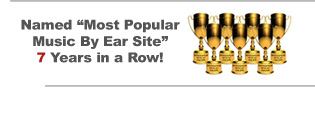In today’s post, we’ll be covering the augmented major seventh chord.
This chord is also known as the major seventh sharp five chord – an interesting, dissonant, and rarely used chord.
Right before we get into its intervallic breakdown and chord formation, let’s reserve some time to define it.
Welcome to week 12 of our free 16-week chord revival program.
Definition of the Augmented Major Seventh Chord
The augmented major seventh chord is basically an augmented triad with a major seventh interval from its root.
Using any augmented triad that we’ve covered in the previous week, you can form the augmented major seventh chord by adding a major seventh tone from the root of the chord.
The major seventh is an interval formed by the relationship between the first and the seventh tones of the major scale. In the C major scale:
…the first and seventh tones of the scale are C and B:
…respectively. Therefore, the relationship between C and B produces a major seventh interval.
If C and B (the major seventh interval):
…is added to the C augmented triad (consisting of C, E, and G#):
This will produce the C augmented major seventh chord:
If you’re looking for a simple way to explain this chord to a layman, search no further. Just define it as an augmented triad with a major seventh.
Intervallic Analysis of the Augmented Major Seventh Chord
Now, to take us further in our understanding of the augmented major seventh chord, we need to break it down to smaller fragments called intervals.
By analyzing these smaller components that make up the chord, we can understand the properties of these chords in relationship with the intervals.
So if we break the C augmented major seventh chord into intervals in relationship with the root, we get:
C and E:
…which is a major third.
The next interval is C and G#:
…which is an augmented fifth.
Finally, we have C and B:
…which is a major seventh.
So, the augmented major seventh chord has three intervallic components:
- The major third
- The augmented fifth
- The major seventh
It is these three intervals that make this chord what it is. So let’s look at what these three intervallic components represent.
The Major Third
The major third is the relationship between the first and third degree of any major scale. The quality of third in a chord determines whether the chord is a major or a minor chord. Considering that a major third is present, that means the augmented major seventh chord is a major chord.
The Augmented Fifth
The term augmented here represents larger intervals. The augmented fifth is a relationship between a note and another note that is a half step higher than the fifth tone of the major scale.
The fifth tone in the key of C major is G. Therefore the augmented fifth can be formed by making this G a half step larger, thus producing C and G#:
…the augmented interval. This is the intervallic component that makes the augmented seventh chord an augmented chord.
The stability of a chord depends solely on the quality of the fifth it’s built with. While the perfect fifth is considered to be universally consonant, any other quality of fifth sounds unstable and unpleasant. Consequently, the augmented major seventh chord is an unstable chord owing to its quality of fifth – the augmented fifth.
The augmented fifth is traditionally considered to be dissonant (in other words, the relationship formed between the root and the augmented fifth sounds unpleasant). This makes the augmented major seventh chord an unpleasant chord (aka – “discord”).
However, due to the fact that the dissonance of yesterday has evolved to the consonance of today, the augmented major seventh chord does not sound very dissonant or unpleasant, as music scholars define it.
The Major Seventh
The major seventh interval is also a dissonant interval. It is formed by the relationship between the first and seventh degree of any major scale.
All seventh intervals are dissonant whether minor, major, diminished, or augmented sevenths.
Because the augmented major seventh chord has a major seventh as its intervallic component, this contributes to its major quality. This is because the quality of third and seventh determines the quality of chord and not just the third. So the augmented major seventh is a major chord because of the quality of seventh it is built with.
It is clear from our analysis that the augmented major seventh chord is an unstable major chord that spans seven degrees from its root.
It is a major chord because of its third and seventh (which are major intervals). It’s unstable because of its quality of fifth (which is an augmented fifth and subsequently the same interval that determines its name). It is a seventh chord because it encompasses seven scale degrees.
Now that you can clearly see the augmented, the major, and the seventh , let’s proceed to its chord formation.
Chord Formation of the Augmented Major Seventh Chord
Chord formation of the augmented major seventh chord can be approached using several techniques.
However, in today’s lesson, I’ll be sharing three common chord formation techniques.
Let’s get started with the first one – the scale approach.
Scale Approach to the Chord Formation of the Augmented Major Seventh Chord
“So how do we form the augmented major seventh chord using a scale?” The scale used in the formation of the augmented major seventh chord is the third mode of the harmonic minor scale.
Using the A harmonic minor scale:
…the third tone is C:
So if we play the A harmonic minor scale from C to C:
…this would produce the third mode of the A harmonic minor scale. When compared with the C major scale:
…you can see the clear difference in the fifth tone.
Attention: The third mode of the harmonic minor scale is known as the ionian #5, which means it’s an ionian mode with a raised fifth degree. You’ll raise the fifth degree of the C major scale by a half step to produce the third mode of the A harmonic minor scale. Pretty much, if you are familiar with major scales in all keys, you can form the third mode of the harmonic minor scale by raising the fifth tone of the major scale by a half step.
For reference purposes, here are the third modes of the harmonic minor scales (aka – “ionian #5”) in all keys:
C ionian #5:
Db ionian #5:
D ionian #5:
Eb ionian #5:
E ionian #5:
F ionian #5:
Gb ionian #5:
G ionian #5:
Ab ionian #5:
A ionian #5:
Bb ionian #5:
Cb ionian #5:
If you are familiar with our pick-skip technique, you can literally use any of the scales above to form the augmented major seventh chord. Here is how it works:
Using the third mode of the harmonic minor scale formed on C:
…we can form the C augmented major seventh chord by picking C:
…skipping D and picking E:
…skipping F and picking G#
…skipping A and picking B:
All the notes we’ve picked so far outline the C augmented major seventh chord and following the same procedure with each scale will produce the augmented major seventh chord in all twelve keys.
Intervallic Approach to the Chord Formation of the Augmented Major Seventh Chord
In this approach, we are using intervals to form the augmented major seventh chord.
Recall that earlier in this lesson, we did a breakdown of the augmented major seventh chord into the following intervals – the major third, the augmented fifth, and the major seventh intervals.
The major third is the relationship between the third and first degree of any given major scale.
The term augmented means larger. Therefore, the augmented fifth interval is larger than the interval formed between the first and the fifth tones of any major scale by a half step.
Considering that the first and the fifth tones of the C major scale are C and G respectively, the augmented fifth interval is simply the relationship between C and G#:
…which is larger than C and G by a half step.
The major seventh is formed by a relationship between the first and seventh tone of any given major scale.
If you are familiar with these intervallic components and can put them together in one octave, you’ll form the augmented major seventh chord.
Here are the three intervallic components in the key of D:
D and F#:
…the major third.
D and A#:
…the augmented fifth.
D and C#:
…major seventh.
Putting these intervals together in one octave will produce the D augmented major seventh chord:
Chordal Approach to the Chord Formation of the Augmented Major Seventh Chord
Our final approach to the chord formation of the augmented major seventh in this lesson favors the use of a chord.
In the beginning of this course, I showed you how the augmented major seventh chord stems from the basic augmented triad [with the major seventh interval]. Knowledge of the augmented triad that we’ve covered in a previous post can put the augmented major seventh chord within your grasp.
Check out these two examples…
The C augmented triad:
…provides you with 75% of the notes you need to form the augmented major seventh chord.
And the remaining 25% is as easy as adding the seventh tone of the major scale of the key you’re forming the chord in. In this case, where the seventh tone of the C major scale is B, we can simply add it:
…to the C augmented triad:
…to produce the C augmented major seventh chord:
The F augmented triad:
…provides us with 75% of the notes we need in the formation of the F augmented major seventh chord.
Adding the seventh tone of the F major scale, which is E:
…to the F augmented triad produces the F augmented major seventh chord:
If you do the same thing in any other key, you’ll also have the same result.
Final Words
The major seventh chord and the augmented major seventh chord are related. The difference is that the fifth is augmented or larger in the augmented seventh chord. Check out these two chords…
C major seventh:
C augmented major seventh:
Can you spot the slight difference between both of them? The answer is: the raised fifth (aka – “augmented fifth”), which is simply called the “sharp five.”
It’s not a bad idea to feature the augmented major seventh chord where the major seventh chord fits into. Here’s a hymn example…
Thank:
…you:
…lord:
Did you see that?
Alright! Although we’re just getting started with the augmented major seventh chord, this is how far we can go for today. We’ll talk more about this chord in a subsequent post.
Ciao!
P.S.
Here are all augmented (aug) major seventh chords on the keyboard. Feel free to learn and memorize them.
C aug major seventh:
Db aug major seventh:
D aug major seventh:
Eb aug major seventh:
E aug major seventh:
F aug major seventh:
Gb aug major seventh:
G aug major seventh:
Ab aug major seventh:
A aug major seventh:
Bb aug major seventh:
Cb aug major seventh:
Chuku Onyemachi
Latest posts by Chuku Onyemachi (see all)
- The Formation Of Diminished Seventh Chords Used To Be Challenging Until I Did This
- How To Form Seventh Chords In Two Shakes Of A Dog’s Tail Using Third Intervals And The Circle Of Fifths Chart
- I Played The 13sus4 Chord And This Happened…
- How To Build Seventh Chords Like An Architect Using “Foundation And Structure” Concept
- This 4-Week Plan Will Help You Master All The Major Scales







Comments on this entry are closed.